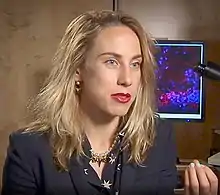Polina Anikeeva
Polina Olegovna Anikeeva (born 1983) is a Russian-American materials scientist who is an Associate Professor at the Massachusetts Institute of Technology.[3][1][4] Her research considers the development of optical devices capable of stimulating brain activity and simultaneously record the electronic signals. She was awarded the 2018 Vilcek Foundation Prize for Creative Promise in Biomedical Science.
Polina Anikeeva | |
|---|---|
 Anikeeva in a National Science Foundation video in 2016 | |
| Born | Polina Olegovna Anikeeva 1983 (age 37–38) |
| Alma mater | Massachusetts Institute of Technology Peter the Great St. Petersburg Polytechnic University |
| Awards | National Science Foundation CAREER Award (2013) |
| Scientific career | |
| Fields | Bioelectronics[1] |
| Institutions | Massachusetts Institute of Technology Stanford ETH Zürich Los Alamos National Laboratory |
| Thesis | Physical properties and design of light-emitting devices based on organic materials and nanoparticles (2009) |
| Doctoral advisor | Vladimir Bulović Yoel Fink[2] |
| Website | bioelectronics |
Early life and education
Anikeeva was born in Saint Petersburg, Russia (then Leningrad, Soviet Union). Her parents were both mechanical engineers.[5] As a child she was interested in science fiction novels.[6] She studied biophysics at Peter the Great St. Petersburg Polytechnic University, where she worked under the guidance of Tatiana Birshtein.[6] During her undergraduate studies she completed exchange programmes at ETH Zurich and Los Alamos National Laboratory. After a summer in New York City, she became increasingly interested in American research and molecular biology.[5] She joined Vladimir Bulović's laboratory of organic electronics at the Massachusetts Institute of Technology (MIT) for her graduate studies.[2] Here she studied nanoparticles, quantum dots and organic electronic materials for light-emitting diodes. Her doctoral research was commercialised by the display industry, and acquired by a manufacturer that would eventually become part of Samsung.[5]
Research and career
After completing her doctorate, Anikeeva moved to the West Coast, and was appointed to Karl Deisseroth's neuroscience laboratory. There she worked on novel approaches to control and investigate the brain using light.[7] Whilst her early devices allowed the monitoring of neural activity in freely moving animals, they were made of rigid materials that were not particularly compatible with the nervous system.[5]
After a brief spell in California, Anikeeva returned to Cambridge, Massachusetts as an Assistant Professor at MIT.[8] At MIT, the Anikeeva laboratory studies implantable devices for the optical stimulation and electronic recording of neural activity.[9][10] Her laboratory combines fibre fabrication for neural probes with fundamental studies in how to interface with the nervous system.[7][11] The fibre is ultra-thin, stretchable and durable, allowing for detailed investigations of neurological conditions. The neural probes make use of magnetic nanoparticles and heat sensitive ion channels. She is interested in the patterns of neural activity that give rise to particular behaviours, which may help to rehabilitate people after spinal cord injury.[7]
Anikeeva gave a TED talk on brain-computer interfaces.[12]
Awards and honours
- 2013 National Science Foundation CAREER Award[13]
- 2013 National Academy of Engineering Frontiers of Engineering Symposium[14]
- 2014 Dresselhaus Foundation Inaugural Award[15]
- 2015 Junior Bose Teaching Award[16]
- 2015 Technology Review TR35[17]
- 2017 SPIE Women in Optics planner[6]
- 2018 Vilcek Prize for Creative Promise in Biomedical Science[5]
Selected publications
Her publications[1] include:
- Anikeeva, Polina O.; Halpert, Jonathan E.; Bawendi, Moungi G.; Bulović, Vladimir (2009). "Quantum Dot Light-Emitting Devices with Electroluminescence Tunable over the Entire Visible Spectrum". Nano Letters. 9 (7): 2532–2536. doi:10.1021/nl9002969. ISSN 1530-6984. PMID 19514711.
- "Natural Neural Projection Dynamics Underlying Social Behavior". Cell. 157 (7): 1535–1551. 2014. doi:10.1016/j.cell.2014.05.017. ISSN 0092-8674. PMC 4123133. PMID 24949967.
- Canales, Andres; Jia, Xiaoting; Froriep, Ulrich P.; Koppes, Ryan A.; Tringides, Christina M.; Selvidge, Jennifer; Lu, Chi; Hou, Chong; Wei, Lei; Fink, Yoel; Anikeeva, Polina (2015). "Multifunctional fibers for simultaneous optical, electrical and chemical interrogation of neural circuits in vivo". Nature Biotechnology. 33 (3): 277–284. doi:10.1038/nbt.3093. ISSN 1546-1696. PMID 25599177.
- Chen, Ritchie; Romero, Gabriela; Christiansen, Michael G.; Mohr, Alan; Anikeeva, Polina (2015-03-27). "Wireless magnetothermal deep brain stimulation". Science. 347 (6229): 1477–1480. doi:10.1126/science.1261821. hdl:1721.1/96011. ISSN 0036-8075. PMID 25765068.
References
- Polina Anikeeva publications indexed by Google Scholar

- Anikeeva, Polina Olegovna (2009). Physical properties and design of light-emitting devices based on organic materials and nanoparticles. mit.edu (PhD thesis). Massachusetts Institute of Technology. hdl:1721.1/46680. OCLC 428140641.
- bioelectronics
.mit .edu 
- Polina Anikeeva publications from Europe PubMed Central
- "Polina Anikeeva". Vilcek Foundation. Retrieved 2020-11-10.
- "Polina Anikeeva | Women in Optics | SPIE". spie.org. Retrieved 2020-11-10.
- "Polina Anikeeva | Innovators Under 35". innovatorsunder35.com. Retrieved 2020-11-10.
- "Polina Anikeeva". MIT McGovern Institute. Retrieved 2020-11-10.
- "Polina Anikeeva". World Economic Forum. Retrieved 2020-11-10.
- "Polina Anikeeva". TEDxCambridge. Retrieved 2020-11-10.
- Peiris, Poornima. "Breaking New Ground In Neural Technology: Dr. Polina Anikeeva". Forbes. Retrieved 2020-11-10.
- Anikeeva, Polina, Why You Shouldn't Upload Your Brain To A Computer, retrieved 2020-11-10
- "NSF Award Search: Award#1253890 - CAREER: Optoelectronic neural scaffolds: materials platform for investigation and control of neuronal activity and development". nsf.gov. Retrieved 2020-11-10.
- "Polina Anikeeva". naefrontiers.org. Retrieved 2020-11-10.
- "Dresselhaus Award announced | MIT DMSE". dmse.mit.edu. Retrieved 2020-11-10.
- "Junior Bose Award | MIT DMSE". dmse.mit.edu. Retrieved 2020-11-10.
- "Technology Review announces TR35 | MIT DMSE". dmse.mit.edu. Retrieved 2020-11-10.